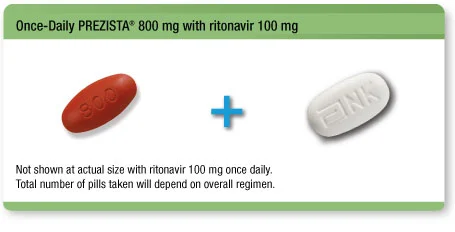PREZISTA®: Single 800-mg Tablet
PREZISTA® (darunavir):
A Reduced Pill Burden* Option

*400-mg tablets are no longer available.
PREZISTA® single 800-mg tablet is smaller than the 600-mg tablet
Once daily dosing is recommended for all
treatment-experienced patients with no DRV RAMs*†
- Once-Daily PREZISTA®—
one 800-mg tablet taken with ritonavir 100 mg once daily and with food—is
recommended for
treatment-experienced adults with no DRV RAMs as part of combination ARV therapy1
Twice daily dosing is recommended for treatment-experienced adult patients with ≥1 DRV RAMs 1
-
The recommended dose is one 600-mg tablet + ritonavir 100 mg twice daily taken with food as part of combination ARV therapy1
For ARV treatment-experienced patients, genotypic testing is recommended1
- When genotypic testing is not feasible, PREZISTA®/r 600/100 mg twice-daily dosing is recommended1
No dose adjustment required for:
- Mild-to-moderate hepatic impairment1
Learn more about dosing information for treatment-naïve patients
† DRV RAMs=darunavir resistance-associated mutations: V11I, V32I, L33F, I47V, I50V, I54L, I54M, T74P, L76V, I84V, and L89V.
ARV=antiretroviral.
Selected Important Safety Information
- Hepatotoxicity: Drug-induced hepatitis has been reported with PREZISTA®/r. During the clinical development program (N=3063), hepatitis has been reported in 0.5% of patients receiving combination therapy with PREZISTA®/r. Patients with preexisting liver dysfunction, including chronic active hepatitis B or C, have an increased risk for liver function abnormalities, including severe hepatic adverse reactions
- Sulfa Allergy: PREZISTA® should be used with caution in patients with known sulfonamide allergy
- Hepatic Impairment: PREZISTA®/r is not recommended for use in patients with severe hepatic impairment. There are no pharmacokinetic or safety data available in patients with severe hepatic impairment
Please see additional Important Safety Information.
Please see full description of study design and baseline characteristics.



